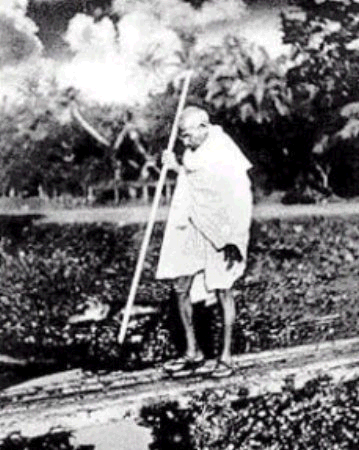 Aarthi's to Lord Ganesh at his Aquem Residence Margao On Sept. 11, 2010…” This message also contained an image illustrating the subject. The body of the email read, “Chief Minister Shri Digamber Kamat, Smt. Asha Kamat and members of the family are seen performing aarthis of the family Lord Ganesh on the occasion of Ganesh Chaturthi at his Aquem residence, Margao on September 11, 2010.”
Aarthi's to Lord Ganesh at his Aquem Residence Margao On Sept. 11, 2010…” This message also contained an image illustrating the subject. The body of the email read, “Chief Minister Shri Digamber Kamat, Smt. Asha Kamat and members of the family are seen performing aarthis of the family Lord Ganesh on the occasion of Ganesh Chaturthi at his Aquem residence, Margao on September 11, 2010.”
To this email, a journalist friend posed the rather understandably irritated question; “Is this ‘news’? Does the citizen of a post-colonial, secular State need to be told about the beliefs and prayers said by his political functionaries?”
 While I can understand the irritation, indeed this column will vent my personal irritation at the ‘news item’ I do not believe that the secular credentials of the Goan State are at stake in this issue. On the contrary, the Indian version of secularism has thrived on the twining of the religious and the political. Or perhaps more correctly the manner in which the political has managed the multiplicity of Indian religious experience. Thus, given a Catholic Chief Minister, and if this press release becomes a trend, we could expect to see the Chief Minister at a feast mass.
While I can understand the irritation, indeed this column will vent my personal irritation at the ‘news item’ I do not believe that the secular credentials of the Goan State are at stake in this issue. On the contrary, the Indian version of secularism has thrived on the twining of the religious and the political. Or perhaps more correctly the manner in which the political has managed the multiplicity of Indian religious experience. Thus, given a Catholic Chief Minister, and if this press release becomes a trend, we could expect to see the Chief Minister at a feast mass.
No, this news item does not challenge the secularism of the Goan State. That secularism is challenged more fundamentally by Digambar Kamat and his police force when they allow the right wing elements to determine what is appropriate culture in this State and what not.
The problem with this news item is that it could set a trend, where a tendency  already exists, of making every little thing the Chief Minister (or politician) does, a matter of interest. Such a news culture walks the dangerous path earlier taken in the construction of totalitarian leaders. Every little action that the great man takes is news, beginning a cult of personality. This tendency is not new to the Indian Republic, it has existed for some time, and has existed in Goa as well. Remember the times of the eighties when our newspapers would be graced by images of MLAs inaugurating shops? What is surprising perhaps is that this tendency picks up even small private moments as the family worship at Chaturthi time.
already exists, of making every little thing the Chief Minister (or politician) does, a matter of interest. Such a news culture walks the dangerous path earlier taken in the construction of totalitarian leaders. Every little action that the great man takes is news, beginning a cult of personality. This tendency is not new to the Indian Republic, it has existed for some time, and has existed in Goa as well. Remember the times of the eighties when our newspapers would be graced by images of MLAs inaugurating shops? What is surprising perhaps is that this tendency picks up even small private moments as the family worship at Chaturthi time.
It is here that the news item demonstrates its troublesome nature, and it is something that Mr. Kamat should give some thought too. To allow the Department of Information and Publicity permission to access his private and family moments sends a signal that his private world is also open for scrutiny and examination. The implications of this are perhaps best seen in the case of  film stars. The success of the film star rests not so much on their acting potential, but on the fact that they are constructed as these beings whose entire lives are up for scrutiny. What this results in is a gross violation of their privacy and that of their families. In the case of film stars, this is what they signed up for. The question for Mr. Kamat (and his tribe of politicians) is whether he would enjoy playing this game. I think not. It opens up the gates for opposing politicians to draw out not just the private moments and scenes of the Chief Minister, but the rest of his family as well. In the offensive and obnoxious attack on Mr. Monserrate’s son, which was really an unfair means to get at the father, we see the problems that such politics brings. We should bear in mind that not all family engagements, or personal moments are as pure and chaste as the aarthi at Ganesh time.
film stars. The success of the film star rests not so much on their acting potential, but on the fact that they are constructed as these beings whose entire lives are up for scrutiny. What this results in is a gross violation of their privacy and that of their families. In the case of film stars, this is what they signed up for. The question for Mr. Kamat (and his tribe of politicians) is whether he would enjoy playing this game. I think not. It opens up the gates for opposing politicians to draw out not just the private moments and scenes of the Chief Minister, but the rest of his family as well. In the offensive and obnoxious attack on Mr. Monserrate’s son, which was really an unfair means to get at the father, we see the problems that such politics brings. We should bear in mind that not all family engagements, or personal moments are as pure and chaste as the aarthi at Ganesh time.
Thus, Mr. Director of Information and Publicity, the news item that you generated is problematic not only because it seems to threaten the secular fabric of our State, but because it smacks of the desire to build a personality cult, something we are better off without. It also opens up the doors for all manner of investigation into the personal lives of the Chief Minister and his family. This is not a good idea, not just for us, but for the sake of Mr. Kamat’s welfare.
(First published in the Gomantak Times 22 Sept 2010)





















